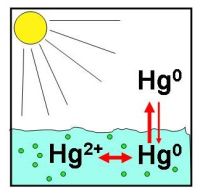
The meaning of cyanobacteria for elemental mercury emissions by the Baltic Sea - Hg-Cyano

The Baltic Sea shows a maximum of elemental mercury (Hg0) release in mid-summer. It is investigated, if the transformation of ionic mercury to volatile Hg0 is actively done by cyanobacteria or if it is caused by photochemical reactions. The study comprises in situ measurements, culture experiments and microbiological analyses.
Mercury (Hg) is subjected to multiple transformation processes in nature. The various Hg species show different physical and chemical properties with the consequences that poisonous mercury can be found everywhere in the environment. Hence, it is important to understand and quantify Hg transport and transformation processes in the environment.
In a preceding project that investigated the Baltic Sea as a source for atmospheric mercury, a clear seasonal emission of elemental mercury (Hg0) was shown (Kuss and Schneider, 2007). The maximum was found in mid-summer at intense solar radiation and a strong cyanobacteria bloom. Various lab studied showed that the potential biotic and abiotic transformations of ionic Hg to Hg0 depend on light. Abiotic would mean that the transformation is directly caused by light as a photochemical process potentially mediated by dissolved organic carbon. Light dependent mercury transformation by cyanobacteria refers to potential genetically determined ability of cyanobacteria to remove Hg.
For the project Hg-Cyano research campaigns have been done in July 2011 on R/V “Elisabeth Mann Borgese” and in June/July 2012 on R/V “Meteor”. The investigation is based on three approaches:
- Some algae and bacteria posses the genetic pre-condition to transform toxic ionic mercury to volatile and less toxic Hg0.
-> The genetic pre-condition of mercury resistance of cyanobacteria is investigated by microbiological analyses. Moreover, it will be figured out which cyanobacteria show an active MerA gene, indicating that the transformation was really done. - Surface water was sampled for ionic mercury as well as for dissolved organic carbon analyses. Hg0 was measured quasi-continuously on-board. In parallel samples the composition of the plankton community is studied with special emphasis on cyanobacteria species.
For comparison deeper water layers were also analysed with regard to plankton composition, light supply, and Hg0 concentration. Reduced light intensity in combination with enhanced nutrient supply could favour biotic transformation by cyanobacteria in the layer between about 10 and 20 m depth.
-> Distribution pattern of cyanobacteria, total mercury, dissolved organic carbon, and light supply are statistically analysed with the concentration distribution of Hg0. - An incubation experiment with unfiltered and filtered surface water from an area with elevated cyanobacteria abundance is aimed to quantify the contributions of biogenic and of the photochemical mercury transformation.
-> Therefore four treatments are compared: An untreated natural sample, a sample subjected to drastically reduced light supply (to 6%), a sample almost freed of bacteria and plankton by filtration, and another filtrated sample that was additionally heated to boiling. During 12 days of incubation twice a day Hg0 was measured in the headspace air. Samples for total mercury, phytoplankton composition, nutrients, and DOC were taken at the beginning and after the incubation.
Preliminary results
In general, the measurements of Hg0 in surface water showed a moderately enhanced Hg0 concentration in most studied areas of the Baltic Sea in summer 2012 (Hg0wat= 26 ± 5 ng/m³). The highest Hg0 concentrations were measured in the north-western Gotland Sea showing peak values of up to 50 ng/m³. This coincided with elevated cyanobacteria abundance in that area. End of July 2011 Hg0 concentrations from about 40 ng/m³ in the western Baltic Sea to 25 ng/m³ in the eastern Gotland Sea were determined. For comparison in July 2006 the Hg0 concentration was 32 ± 4 ng/m³ in the eastern Gotland Sea (Kuss and Schneider, 2007).
The incubation experiment in July 2012 was started with seawater from the cyanobacteria bloom area. Strongest production was recorded during day-time, with highest amounts of Hg0 in the headspace of the untreated natural sample. As expected in the reduced light (to 6%) sample daily Hg0 was about one fourth of the natural sample. But also the presumed important photochemical production in the sterile samples contributed only a minor amount to the total natural production.
Dr. Joachim Kuss (PI) with contributions of other groups:
Dr. Matthias Labrenz , Dr. Norbert Wasmund, Dr. Klaus Nagel, Dr. Monika Nausch, Dr. Herbert Siegel und Siegried Krüger.
References
Kuss, J. and Schneider, B., 2007. Variability of the gaseous elemental mercury sea-air flux of the Baltic Sea. Environmental Science and Technology, 41(23): 8018–8023.